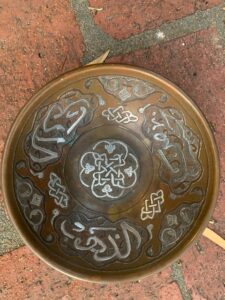 GH received this Persian-style brass bowl inlaid with silver as a holiday gift. She asked me to trace its unique combination of metals, style, and history.
GH received this Persian-style brass bowl inlaid with silver as a holiday gift. She asked me to trace its unique combination of metals, style, and history.
This is a five and half inch wide bowl, in the style of the ancient metalworkers of Khorassan, Northeastern Iran, of the 13th century. It also resembles the 14th century style of Fars metalwork of Western Iran. More about the value of those ancient vessels later, but the styles experienced a revival years later.
In the late 19th to the early 20th century Middle Eastern metalcraft revived the ancient Mamluk Ottoman style, and the ancient Cairo style. Both styles featured silver inlay on brass or copper, essentially the same thing because brass is an alloy of copper and zinc. How a combination of silver and brass became a style in the 12th century and lasted till today tells an interesting story involving etymology. Iranian scholars traced the style back to the Arabic/Persian word for brass, ‘berenj’ to pre-Islamic words.
Berenji
The word berenji may be pre-Islamic onomatopoeia for the “ring” sound a brass vessel makes when struck, and the word passed to Persian as “tarang,” Old German as “dringen,” and English as “ring.” That tells you a little about what they used brass for, such as “bell metal.”
Silver tableware became popular in the courts of Persia in the 12-13th century, despite Muslim tradition banning the use of precious metals for eating and drinking. However, silver became desirable, and not an abundant natural commodity in Iran, thus they developed silver inlay. Whatever they made in gold, they also made in brass, with a similar look.
Arabic calligraphy in the bowl
They call the words ‘nasksh,’ or benedictory words, phrases, and snippets of poems, blessings inscribed. Of course you don’t see realistic representation of flowers in the designs, but you do see abstract representations of natural elements. You also see a silver lappet. This design emphasizes the diameter of the bowl, on the outside in, appropriately, arabesques, where we get the word for this particular shaped design popular on Middle Eastern objects.
Ancient Persians used brass for MANY things. Because they often inlaid it with silver, when wars and conflicts broke out through the years, the silver was smelted down. As a result not many truly ancient metalcrafts works exist. Yet people widely collect them, especially the elaborate scientific instruments made of brass inlaid with silver, such as the inventions called the astrolabe. In fact, metalworkers made ancient brass inlaid with silver in much the same fashion as GH’s little 19th century bowl. A brass object is formed from sheet metal hammered into shape, engraved, and inlaid with silver. We don’t do carbon dating of brass, so some fraudsters published the recipes for forging astrolabes in Creating Antiques for Fun and Profit (1977)!
Vessels in this style are ewers, rosewater sprinklers, bracelets, bells, bowls, beakers, basins, samovars, teapots, and horse equipage. We also see them in traditional architecture as openwork studs for doors, and public fountains and water taps.
Brass Bowl Price Differences
You’ll find a large price difference between ancient vessel of brass with silver inlay and a 19th century version, although they look similar. Christies sold a vessel from the 13th century of this form for over $15,000 in March 2022, however to a customer outside the US. WHY? Because the USA prohibits the purchase of “works of conventional Iranian craftsmanship” to US based persons. That category includes objects such as carpets, textiles, decorative pieces, and scientific instruments. Christies put a disclaimer on its auction site saying no sales allowed to US persons.
You might say, “I must have this 13th century bowl.” You might ask your uncle in London to buy this thing of beauty from Persia for you. If purchased by your uncle in England, for import to you in the States, it will undergo months of paperwork through the US Office of Foreign Assets Control.
Your uncle will need a license to send the vessel to you, because the US Treasury Department sanctioned transactions with Iran. Only under special circumstances will they allow you a license to engage in such a transaction, due to perceived threats to US foreign policy. Thus, objects of great beauty suffer. GH’s is neither antique nor publicly traded, and worth $350.